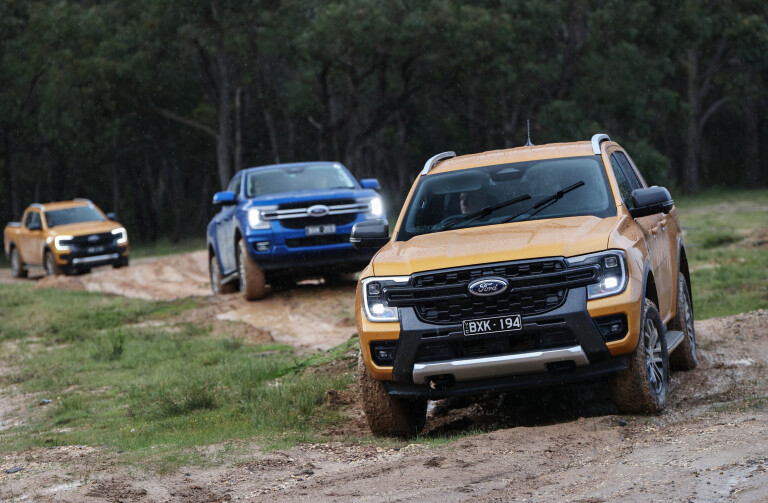
Things we like
- Improved performance and refinement of V6 engine
- Level of interior equipment
- Attention to usability and functionality
Not so much
- No manual transmission offered
The 2023 ‘next-gen’ Ford Ranger is finally here and cars are heading out of showrooms to owners who ordered their new utes months ago. Ford Australia says it has more than 17,000 pre-orders for the new Ranger and hopes to fulfil them with 20,000 vehicles arriving over July and August.
While we’d driven prototypes of the new P703 Ranger in the past, this was our first steer of the production models and here at the launch, we had time behind the wheels of several different 4x4 models.
The regular (non-Raptor) P703 Ranger is available in five model variants from XL to XLS, XLT, Sport and Wildtrak with prices starting from $35,930 through to $70,190 plus ORC. A new Ranger Raptor will arrive in August priced from $85,490.
Ranger Wildtrak
Our series of drives on the launch started from the top of the range with the Wildtrak which is powered exclusively by the 3.0-litre diesel V6 engine. The ‘Lion’ V6 engine is new to the Ranger brand and puts out 184kW of power at 3250rpm and 600Nm of torque giving the Ford Ranger the most grunt in the four-wheel-drive ute class.
As in the past, the Wildtrak is more than just a dress-up pack and stepping in to the interior of the new model you are greeted with new design and shape powered leather seats and the 12-inch portrait layout infotainment screen. Lower models get a still sufficient 10-inch version of this screen.
Even though Ford has fitted these big new screens to the Rangers, the designers haven’t forgotten about functionality and have gifted us with individual dials for HVAC temperature adjustment and audio volume controls – thank you, Ford!
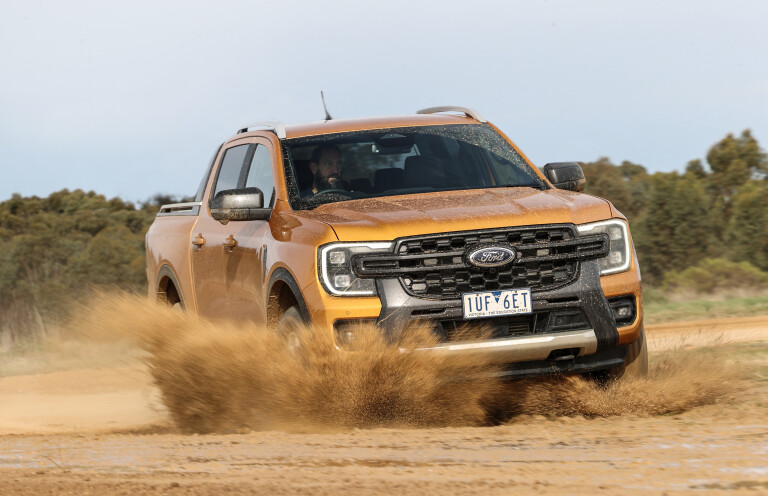
Another welcome addition is that the steering column on all variants is now adjustable for both height and reach allowing drivers of all sizes to get the best driving position. The ignition start/stop button is rightfully placed on the right-hand side of the steering columns, where an ignition key would normally go making it easy to find for drivers who might use more than just the one same model of car.
Press that start button and the V6 diesel fires to life with a low, smooth rumble.
The V6 engine is backed by an updated version of the 10-speed automatic transmission seen in the previous generation of Ranger. It now gets a new short-throw electronic gear shifter that is placed in a conventional position in the centre console. Buttons for manual gear selections once in Drive are on the right-hand side of the shifter where the driver’s thumb finds them.
Selecting Drive and heading through the suburbs, my first feeling was of how far the front corners of the car seem to be. The P703’s 500mm of extra wheelbase all sits between the driver and the front axle and the bonnet is bigger and longer. Thankfully, the front end of the Ranger is quite blunt so those somewhat distant front corners are visible where you need to see them.
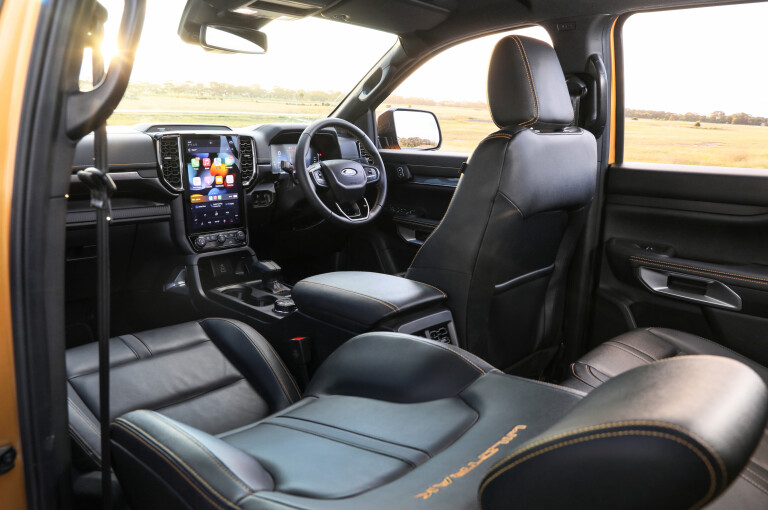
On these low-speed suburban streets, the refinement of the V6 engine over anything an inline 4-cylinder engine could ever deliver, becomes evident. It continues as we merge on to the highway and are greeted with seamless mid-range torque as the Wildtrak accelerates up to speed.
The V6 diesel doesn’t make the Ranger a rocket ship by any means but the smooth, refined way it delivers its improved performance makes the drive experience far better than that of the bi-turbo 4-cylinder. The V6 should also trump the I4 when it comes to hauling a load, be it in the tray or on a trailer.
The Ranger Wildtrak is also available with the bi-turbo I4 diesel engine as are the Sport and XLT 4x4 models, and as in all of them it is $3000 less than the same car with the diesel V6.
Ranger Sport
The next rung down the Ranger ladder finds a new model that has been added to the range – the Ranger Sport, and again it’s available with the V6 or I4 diesel engines, both backed by the 10-speed automatic transmission and 4x4 only.
The Sport is distinguished by its all-black grille and model-specific alloy wheels and misses out on a few things from the Wildtrak like the cargo tub sports bar and powered roller cover, automatic parking, and the 12-inch centre touchscreen is replaced by the shorter 10-inch unit that retains all the same features.
The car we were in was powered by the V6 engine, so it starts at $66,690.
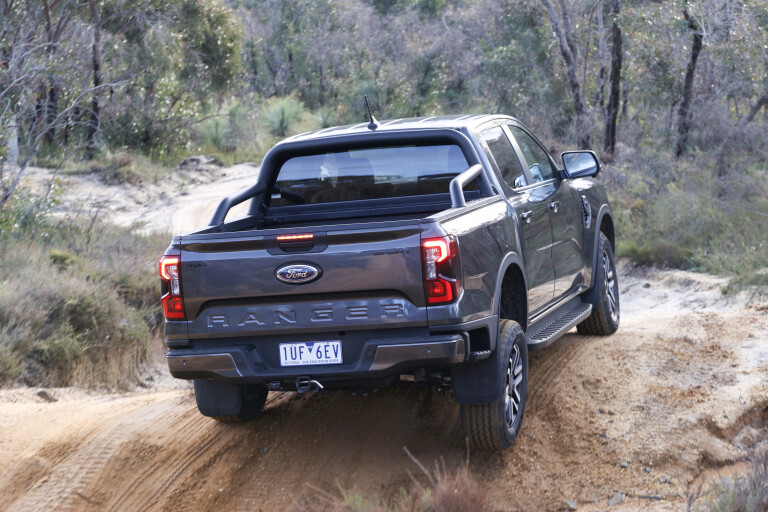
While the drive experience in the Sport was pretty much the same as that in the Wildtrak, sans the suburban bits, it gave us a good opportunity to experience the Ranger’s new full-time 4x4 system.
The full-time 4x4 system is standard on all V6 4x4 Rangers, including the petrol-fuelled V6 Ranger Raptor. The system offers drivers the choice of conventional two-wheel drive (rear wheels); 4x4 Auto; locked 4x4 high range; and locked 4x4 low range.
The benefit of 4x4 Auto is that it can be used on all roads including hard sealed surfaces where you couldn’t normally use 4x4 in a part-time system. This is specifically beneficial on roads that change from sealed to gravel, snow and ice covered roads or even wet roads, and is especially beneficial when towing a load and you need to maintain control.
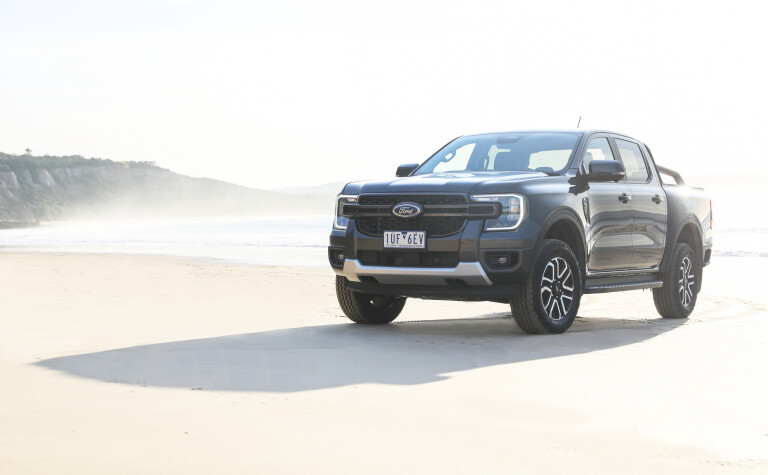
On this day, the weather turned to heavy rain on secondary roads and the superior road-holding ability of the full-time system was apparent on twisting corners and when accelerating away from a stop at intersections.
Only the Mitsubishi Triton and Volkswagen Amarok offer this tractive and safety advantage in the 4x4 ute category.
Ranger XLT
Next rig was a Ranger XLT, again powered by the V6 and 10-speed. The XLT has always been that mid-range model that is popular with buyers that don’t want all the bling but still appreciate a few features and luxuries. The almost perfect blend of workhorse and family adventure rig.
You really start to notice the features dropping out of the specification when you step from Sport to XLT. The seats are cloth with manual adjustment, the pad for wireless charging your phone is not there (wireless Apple and Android connections still standard), the off-road button is gone from the console as there is no off-road screen on the display (but it’s still a 10-inch size) and the alloy wheels drop down to 17s. Certainly no deal breakers in there.
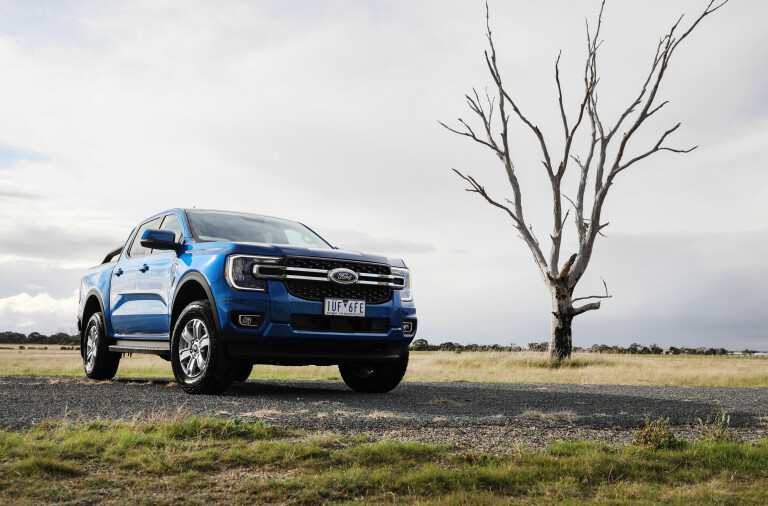
When you get in to the model with the bi-turbo engine you see the console changes back to one without the dial for off-road controls and the gear shifter reverts back to the one carried over from the previous generation.
The now familiar 2.0-litre I4 bi-turbo diesel engine still makes 154kW at 3750rpm and 500Nm from 1750 to 2000rpm and backed by the 10-speed automatic and part-time 4x4 in the Ranger.
Put your foot down in a P703 Ranger with the 4-cylinder and it still provides plenty of poke. In fact, we don’t think it would be giving too much away to the V6 in a zero to 100km/h sprint. The difference is the way it delivers its 500Nm of torque. The 4-pot makes all its grunt at the peak of its revs and it gets there quickly. It’s also quite raucous as most inline-four diesels are. It doesn’t matter how many balance shafts you put in them, an I4 will be inherently rough.

The V6 on the other hand delivers its grunt smoother right through the revs and it’s more refined in how it goes about it. This makes it more relaxing and pleasant to drive over any terrain or conditions.
We don’t like to rely on OBC readings for fuel consumption figures, but as we weren’t filling the cars on this drive that’s all we had. Using them as an indicator there wasn’t a lot of difference in fuel use between the V6 and I4 engines in the Rangers.
Official figures for the same XLT 4x4 with the I4 rate it at 7.2L/100km combined compared to 8.4L/100km for the V6 in the same car. On this drive the dashboards were indicating the I4 at 10.1L/100km and the V6 at 10.7L.
It will be interesting to see how they perform in measured tests in the real world but we’re thinking that the $3K extra for the V6 would be money well-spent.
A single turbocharger variant of the 2.0L diesel engine is offered in 4x2 and XL 4x4 model Rangers. It produces 125kW at 3500rpm and 405Nm from 1750 to 2500rpm and will be backed by the 6-speed automatic transmission carried over from the current generation Ranger. We didn’t get to sample this engine at this launch event.
Off-road
The off-road section of the test started at the Australia Automotive Research Centre (AARC) proving ground where there is a range of different tracks and terrain to test the various components of any car or truck. It had been raining so the clay-based tracks were wet; not ideal for any car on road tyres.
Steep gradients showed the benefits of downhill speed control – both forward and in reverse, and the usefulness of the forward-facing camera when you crest a bind hill.
A 40-per-cent-grade gravel hill tested out the electronic traction control and the effectiveness of the rear differential lock which is standard on all 4x4 Rangers. All these were done with ease as you would expect on a course set out by the manufacturer.
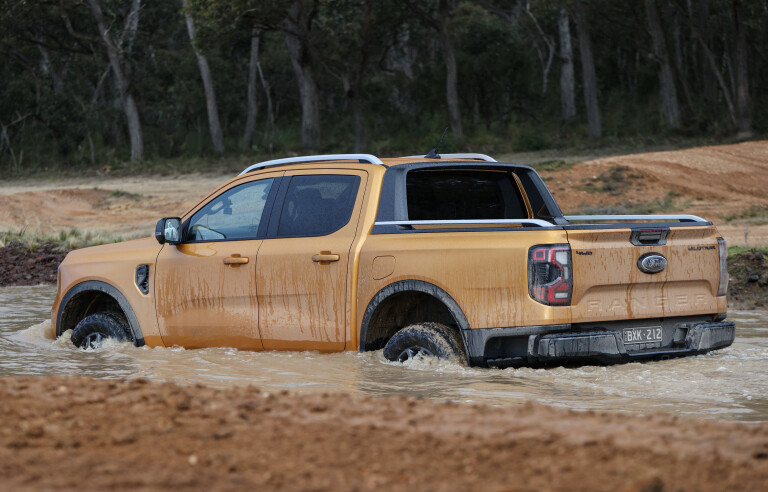
The conditions were a bit more testing once we reached the off-road arena where various humps, mounts, rocks, slopes and 600mm water bath showed the limits of the cars.
The clay here was extra slippery especially after more Rangers ran over it, requiring several attempts for some drivers as they struggled for grip. All in all the Rangers performed admirably considering the conditions.
Rangers now come with a Multi Terrain Selector which was previously only offered on the Raptor and Everest wagon. There are now up to seven modes in the system: Normal, Eco, Tow/Haul and Slippery for on-road use, with Mud/Ruts and Sand modes for off road. Ranger Raptor remains the only variant to turn the dial up to 11 with Baja mode and includes a Rock Crawl mode.
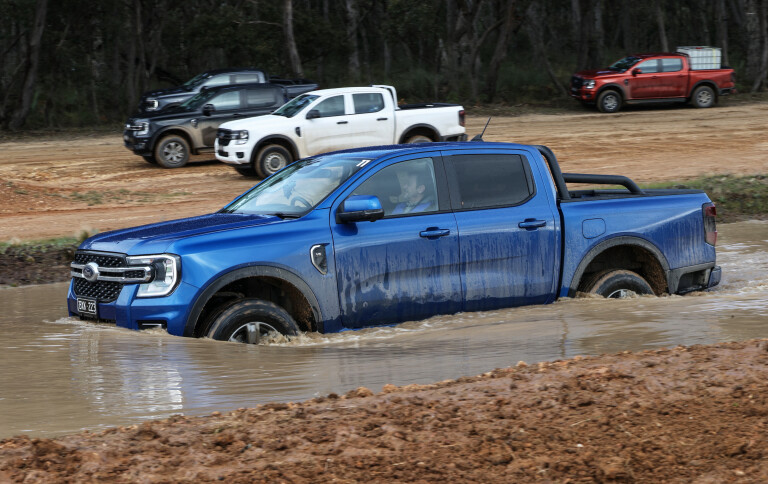
These modes select the optimal calibration for systems such as traction control, transmission shifting, stability control and accelerator response to suit the driving conditions.
Simply selecting the appropriate mode for the terrain you are faced with will make other transmission choices for you without having to push more buttons.
Selecting the Mud/Ruts mode for the track we were on automatically shifts the transfer case to low range. Locking the rear diff or selecting hill descent control can be done via console buttons or on the off-road screen.
A drive on forestry tracks in the Otway Ranges did prove more challenging as the tracks remained wet and slippery, and as the ascents grew steeper the road tyres showed their limits. It was no place for any car on road tyres and we did have to backtrack on a couple of occasions.
Loaded up
While we didn’t get to do any towing with the new Ranger on the launch, we did see a demonstration of the trailer lights checking function which, when activated, cycles through the lights so you can check the ones on your trailer are all working without outside assistance. A very clever function indeed.
New Rangers have a 3500kg towing capacity and depending on the model, come with towbars, wiring and electronic brake controllers.
We did have a chance to drive a V6 Ranger on the highway that had a pair of full 200-litre drums strapped in the tray equalling around 400kg of load. The load softens the ride in the ute, but not in a detrimental way. It was more comfortable while remaining composed, and the powertrain didn’t feel like it noticed the load at all.
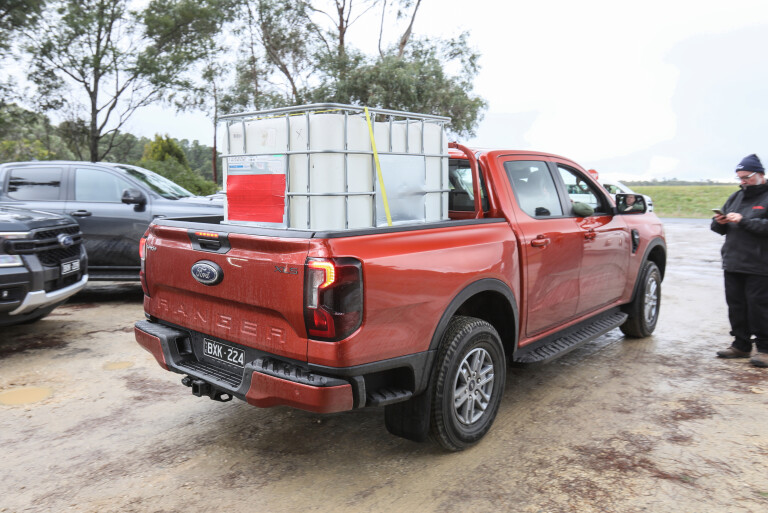
Initial feelings in the unladen Ranger were that the coil front/leaf rear suspension felt firm and you do expect that in a 1-tonne ute without any cargo on board. Yet it was never jittery or uncomfortable, always remaining composed and controlled.
On country backroads you can feel and appreciate the added stability of the back end, thanks in part to the 50mm wider wheel track (front and rear) plus Ford moving the shock absorbers outwards to the outside of the chassis rail where they can better control lateral movement. It all makes for better ride and handling which is less truck-like yet still able to carry a load.
2023 Ford Ranger V6 specs
| Body | 4-door, 5-seat dual-cab ute |
|---|---|
| Drive | all-wheel |
| Engine | 3.0-litre V6 turbodiesel |
| Transmission | 10-speed automatic |
| Power | 184kW @ 3250rpm |
| Torque | 600Nm @ 1750-2250rpm |
| Bore stroke (mm) | 84.0 x 90.0mm |
| Compression ratio | 16.0:1 |
| 0-100km/h | 9.5 sec (estimate) |
| Fuel consumption | 8.4L/100km (combined) |
| Weight | 2346kg |
| Suspension | MacPherson strut front/leaf spring rear |
| L/W/H | 5370mm/1918mm/1886mm (Wildtrak) |
| Wheelbase | 3270mm |
| Fuel tank | 80 litres |
| Brakes | 341mm ventilated discs, two-piston calipers (f) 332mm ventilated discs, single-piston caliper (r) |
| Tyres | 255/65 R18 Goodyear Wrangler Territory AT/S (Wildtrak) |
| Wheels | 18-inch alloy ( full-size spare) |
| Price | $66,690 + on-road costs |
| Wading depth | 800mm |
2023 Ford Ranger pricing
| Variant | Price | Change from previous model |
|---|---|---|
| XL 4x2 HR Single CC 2.0L SiT 6AT | $35,930 | $1,040 |
| XL 4x2 HR Super CC 2.0L SiT 6AT | $38,430 | $1,040 |
| XL 4x2 HR Double CC 2.0L SiT 6AT | $40,430 | $1,040 |
| XL 4x2 HR Double PU 2.0L SiT 6AT | $42,330 | $1,540 |
| XL 4x4 Single CC 2.0L BiT 10AT | $47,030 | $1,740 |
| XL 4x4 Super CC 2.0L BiT 10AT | $49,530 | $240 |
| XL 4x4 Super PU 2.0L BiT 10AT | $51,430 | $2,240 |
| XL 4x4 Double CC 2.0L SiT 6AT | $48,030 | $740 |
| XL 4x4 Double CC 2.0L BiT 10AT | $51,530 | $240 |
| XL 4x4 Double PU 2.0L SiT 6AT | $49,930 | $1,240 |
| XL 4x4 Double PU 2.0L BiT 10AT | $53,430 | $740 |
| XLS 4x2 HR Double PU 2.0L BiT 10AT | $46,730 | N/A |
| XLS 4x4 Double PU 2.0L BiT 10AT | $54,330 | $1,840 |
| XLT 4x2 HR Double PU 2.0L BiT 10AT | $53,990 | $700 |
| XLT 4x4 Super PU 2.0L BiT 10AT | $59,190 | $0 |
| XLT 4x4 Double PU 2.0L BiT 10AT | $61,190 | $0 |
| XLT 4x4 Double CC 3.0L V6 10AT | $62,290 | N/A |
| XLT 4x4 Double PU 3.0L V6 10AT | $64,190 | N/A |
| Sport 4x4 Double PU 2.0L BiT 10AT | $63,690 | N/A |
| Sport 4x4 Double PU 3.0L V6 10AT | $66,690 | N/A |
| Wildtrak 4x4 Double PU 2.0L BiT 10AT | $67,190 | $1,100 |
| Wildtrak 4x4 Double PU 3.0L V6 10AT | $70,190 | N/A |
| Raptor 4x4 Double PU 3.0L V6 EcoBoost 10AT | $85,490 | N/A |
Things we like
- Improved performance and refinement of V6 engine
- Level of interior equipment
- Attention to usability and functionality
Not so much
- No manual transmission offered



COMMENTS